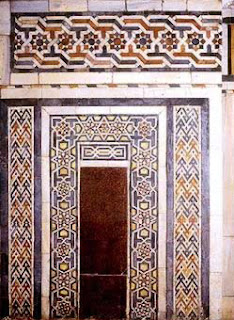Al-Burdayni Mosquee
Cairo
is often called the city of minarets in 1000, but it can actually be
more than many small mosques and even more who really do not need, and
were built without minarets. Cario
everywhere, there are many small mosques and even today, a number of
relatively wealthy members of the Muslim mosques or private funds in
small populated Cairo. This is a tradition that has carried out since ancient times. Al-Burdayni mosque is a gem of a structure traditionally dated between 1616 and 1629. However, it was completed in 1694 by a wealthy merchant. It
was started by a religious scholar named Karim al-Din al-Burdayni who
lived in the Ottoman period, but that was not a Turk, or even a member
of the ruling class, but an Egyptian sheikh rite Shafi ' i. Therefore, there was no real royal support for this facility primarily funded by the private sector. Perhaps
because of this, the minaret is not characteristic of the Ottoman
style, and in fact the entire facade is totally Mamluk a renewal period
Qaytbay.
It
is a very small mosque, in fact no larger than a square room with a
raised gallery at the north-west end, though richly decorated. The
walls are completely covered in marble panels, marble arches and mosaic
and marble roundels, while the reflections of soft golden ceiling and
the windows burst of color. Located in the Dawudiyya area not far from the much darker Malika Safiyya Mosque, it is an architectural jewel.
The mosque has two facades. Western provides the input to the minaret on the right side gate. The history of the fist is octagonal minaret, while the second part is carved. The
final upper consists of a bulb sitting on a balcony stalactites, and is
an imitation of the late Mamluk minarets with a first story ornate
carved keel semicircular niches framed by moldings. The two balconies on the rest of the minaret stalactites of different models. Therefore,
the only real difference between this and old Mamluk minaret structures
is that the bulb is not centered on an octagonal pavilion, but located
directly above the upper balcony. However, the quality of the sculpture is less refined than the period Qaytbay. This
is the only period Ottoman minaret with an inscription band, here
placed on the octagonal section dating from 1623, much later than the
mosque itself.
The mosque is L-shaped, with the qibla wall completely covered with polychrome marble panels. Other w3alls have a strong marble dada. The windows have both stucco decorations and stained glass color. The
prayer niche, richly decorated with inlaid marble and blue glass paste,
is one of the finest examples of decoration in the Mamluk tradition,
while the ceiling is richly painted.
 |
Detail, Windows and Doorway of the Mosque of al-Burdayni
|
 |
More Details, including (right) the minarets
|













No comments:
Post a Comment